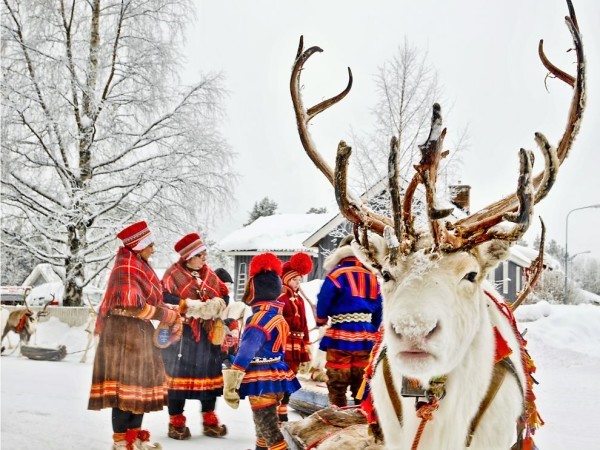Wind, Land and Justice: The Sámi Struggle Against Green Colonialism in the Nordic Arctic
How wind energy development in Northern Scandinavia threatens Sámi rights, reindeer herding and climate justice
How ‘clean’ energy exploits marginalised populations
In efforts to mitigate climate change, renewable energy has been championed as the solution to our environmental crisis. However, beneath the rhetoric of sustainability lies a darker reality: the ongoing exploitation of Indigenous lands and livelihoods. The struggles the Sámi people in the northern parts of Norway, Sweden, Finland and Russia have faced against wind energy developments, particularly the Fosen wind farm in Norway, exposes the enduring legacy of colonialism under the guise of green energy. Their fight raises questions of climate justice: who really benefits from clean energy, and who pays the price?

Green colonialism and renewable energy
Green colonialism refers to the way environmental policies, conservation efforts or renewable energy projects disproportionately exploit or displace Indigenous and local communities, often reinforcing historical colonial power relations. The push for large-scale renewable energy projects often ignores Indigenous sovereignty, echoing imperialist patterns of land dispossession. While these projects are justified as essential for reaching Net Zero, they frequently come at the expense of marginalised populations whose voices are systematically excluded from the decision-making processes.

The Fosen Wind Farm: a case of green land grabbing
The Fosen wind farm, one of Europe’s largest onshore wind energy projects, consists of nearly 300 turbines built on land traditionally used by Sámi reindeer herders. This development was approved despite protests from Sámi communities who argued that it would disrupt crucial winter grazing lands for their reindeer. The Sámi people’s concern isn’t with green energy itself, rather, the way operations target Indigenous lands as ‘sacrifice zones’ for production. In 2021, the Norwegian Supreme Court ruled that the wind farm violated the Sámi people’s rights under international human rights laws, specifically Article 27 of the United Nation’s International Convent on Civil and Political Rights.
Yet, despite this ruling, the turbines remained and the land was not returned to the Sámi. What is framed as a necessary step towards a greener future is, in reality, a continuation of colonial practices through what scholars refer to as ‘green land grabbing’. In the name of sustainability, Indigenous lands are seized without consent and traditional ways of life are threatened to the point of destruction.
Colonialism in an age of climate change
The Sámi struggle against wind energy development is part of a broader global pattern: the sacrifice of marginalised communities for the benefits of wealthier populations and industries. Historically, colonialism justified the extraction of natural resources from Indigenous lands in the Global South to facilitate Western economic progress. Today, the logic and its outcomes remains the same, except the justification has shifted to climate mitigation.
Crucially, this exploitation is not limited to Norway. Similar instances of green colonialism are occurring worldwide, from lithium mining in Indigenous territories in South America to hydroelectric dam projects displacing communities in Canada. While not denying the significance of an energy transition to solve the climate crisis, the global push for renewable energy is inherently unjust: it reproduces oppressive and exploitative hierarchies of power between the Global North and the Global South.

The cost of ‘clean’ energy
The clean energy industry is dominated by multinational corporations and state-backed enterprises that reap economic rewards while burdens fall disproportionately on Indigenous and marginalised communities. In the case of the Fosen wind farm, the Norwegian government and private investors benefit from renewable energy subsidies and increased wind energy production, while the Sámi bear the consequences of displacement, cultural erosion and economic hardship.
Reindeer herding is not solely an economic activity, it is a cultural and spiritual tradition deeply rooted within Sámi identity. The loss of grazing lands threatens the survival of this tradition, forcing many Sámi into alternative livelihoods that stray from their heritage. The destruction of reindeer herding communities for the sake of clean energy illustrates a fundamental hypocrisy: solutions to climate change should not come at the expense of Indigenous survival.

A just climate future? Rethinking sustainability
If climate justice is to be truly just, it must recognise and uphold Indigenous sovereignty. Renewable energy projects must be developed in collaboration with Indigenous communities, rather than at their expense. Solutions exist: community-owned renewable energy, co-management agreements, and policies that prioritise Indigenous lands. But they require a fundamental global shift in how sustainability is conceptualised and implemented.
The Fosen case is a warning that efforts to fight climate change must not replicate the injustices of the past. The struggle of the Sámi people against wind energy development extends beyond reindeer herding: it is about the right to exist, the right to cultural continuity, and the right to determine one’s own future. As the world transitions to renewable energy, we must ask whose voices are being silenced in the process, and at what cost?
In the global push towards Net Zero, climate justice must be more than a slogan plastered on climate mitigation and adaption efforts with little thought. Without addressing the systemic inequalities that underpin green colonialism, the clean energy transition risks cementing itself as yet another chapter in the long history of Indigenous dispossession and exploitation. The true measure of sustainability is not just in atmospheric carbon reductions but in the ability to uphold human rights, protect cultural heritage and ensure that the future we are building is equitable for all.
Sources
https://www.nsenergybusiness.com/projects/fosen-vind-project/
https://www.nib.int/releases/nordic-investment-bank-lends-to-wind-power-in-norway
https://earth.org/green-colonialism/
https://climatalk.org/2024/05/23/what-is-green-colonialism-and-how-do-we-decolonise-policy/
https://www.tandfonline.com/doi/full/10.1080/03066150.2012.671770
https://geographical.co.uk/news/green-energy-projects-are-making-grabs-for-poorly-protected-indigenous-lands
https://www.taylorfrancis.com/chapters/edit/10.4324/9781003118633-10/green-colonialism-b%C3%A5rd-k%C3%A5rtveit
https://munin.uit.no/handle/10037/29387
https://www.sciencedirect.com/science/article/pii/S0160791X24001118
https://onlinelibrary.wiley.com/doi/full/10.1002/jcop.22422
https://www.arcticwwf.org/the-circle/stories/climate-change-and-green-colonialism-in-the-sapmi/
Source links for images:
Image 1: https://skandihome.com/skandiblog/uncategorized/sami-culture-customs/
Image 3: https://apnews.com/article/norway-protest-wind-farm-sami-reindeer-25fed73e79b5ce9aff8eef9d53af7dc8
Image 4: https://www.fosenvind.no/vindparkene/reindrift/The-Fosen-development-and-reindeer-husbandry/